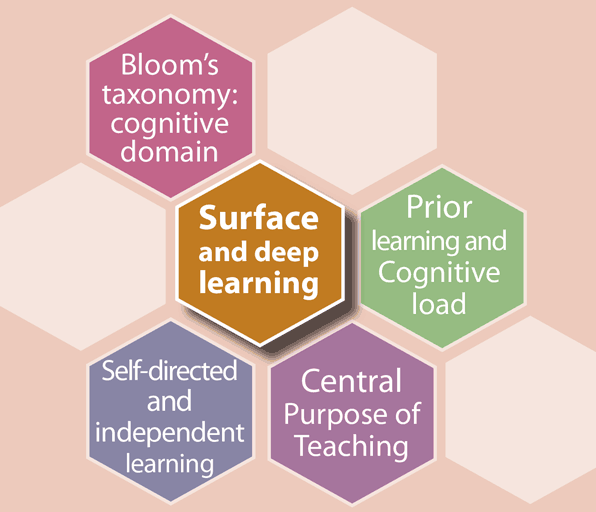Introduction
Not all learning is the same. Sometimes, for a number of reasons (perhaps poor educational environment and policy1,2) students avoid the hard work of deep learning and instead fall back on surface learning practices (to a greater or lesser extent). Being able to identify these practices allows astute and conscientious educators to diagnose problems in the organization of courses or curricula.
Learning Objectives (what you can reasonably expect to learn in the next 15 minutes):
- Classify brief descriptions of approaches to learning as surface or deep, or neither.
- Describe reasons learners might engage in deep or surface learning.
- Explain the importance of being able to recognize these approaches to learning.
To what extent are you now able to meet the above objectives? Please record your self-assessments(0 is not at all and 5 is completely).
Surface and deep learning

To get started, please take a few moments to consider your own approaches to learning. Did you ever use what you think might have been a deep or surface approach to learning? Why or why not?
Let's start with deep learning sometimes called meaningful learning. Many times in the past you have undoubtedly experienced this type of learning, one that is focused on understanding what's really going on, learning the deeper or underlying meaning of the material. Just memorizing the answer or knowing the material at a shallow level was not good enough. Using Bloom's Taxonomy we might say that learning goes beyond remembering to understanding, applying, and even problem-solving. Most teachers would say they want their students to engage in this type of learning. (Unfortunately, many teachers unknowingly create conditions in their courses that make it difficult for students to devote time and effort to deep learning.)

Sometimes our courses might be so demanding and packed with content and/or assignments that students can't find the time or energy to engage in deep learning. The organization of courses and curricula affect student approaches to learning.1,2 Students might turn to surface learning practices like cramming and memorizing answers rather than taking the time to try to understand how what they are learning is connected to other knowledge they have and to real life situations.
Many students will ask us, "Is that on the exam?" This is a clear indication that students are being strategic. With so much to learn (in your course or perhaps in other courses they are taking) they don't have the time or energy to try to understand or become good at solving problems at that level.
Students might also turn to surface approaches because they are not motivated in your subject as they may be in others they are taking. They may not be very motivated for a time if they have personal issues to deal with (financial or family situations, for example) or they just need the course for credit so they can move on (and don't believe they will return to this subject matter again). There are many reasons that students don't engage in our courses. Blaming them is not helpful as it deflects our effort away from teaching strategies that might have a positive effect on students. (For examples and further elaboration please see the reading referenced below especially Meyer, 2002.)
Check for understanding
Self-assessment
Did these expert explanations make sense and help you better understand the objectives? Please tell us your experience in the short evaluation coming up soon. But first, please complete the following very short self-assessment on the objectives of this CORAL cell.
To what extent are you NOW able to meet the following objectives? (0 is not at all and 5 is completely)
Objectives
To what extent WERE you able the day before beginning this CORAL Cell to meet the following objectives? (0 is not at all and 5 is completely)

Thank you for completing this CORAL Cell.
We are interested in improving this and other cells and would like to use your answers (anonymously of course) along with the following descriptive questions as part of our evaluation data.
Thanks again, and come back soon!
The CORAL Cell Team
References
1 Grant J. Principles of curriculum design, p. 37. In T. Swanwick (Ed.) Understanding medical education: Evidence, theory and practice pp. 31-46. 2nd ed. Chichester, West Sussex: John Wiley & Sons, Ltd., 2014.
2 Meyer RE. Rote versus meaningful learning. Theory into Practice 2002;41(4):226-232.
For further reading
Cutting MF & Saks NS. Twelve tips for utilizing principles of learning to support medical education. Medical Teacher, 2012;34:20-24.
Credits
Author: Sean Polreis, Marcel D’Eon, University of Saskatchewan
Series Editor: Marcel D’Eon
Reviewer/consultant: Deirdre Bonnycastle
